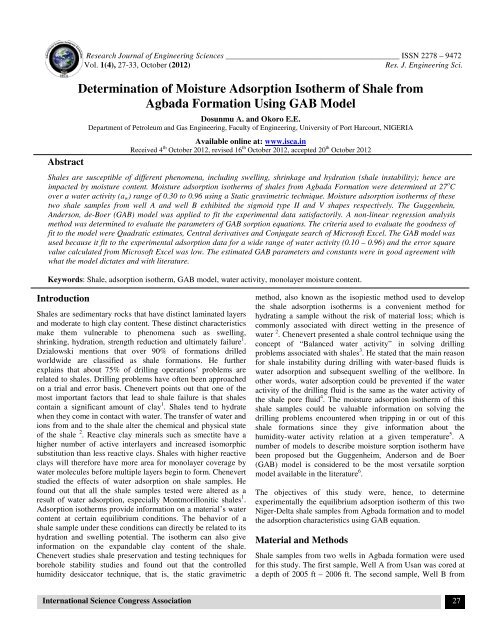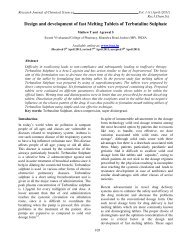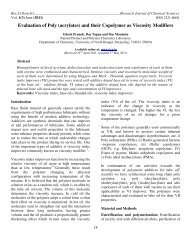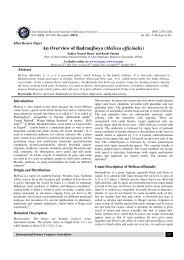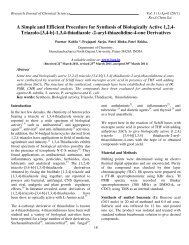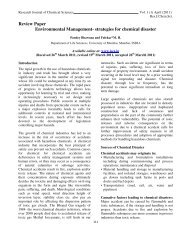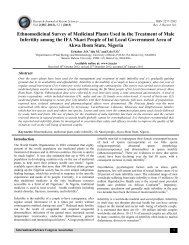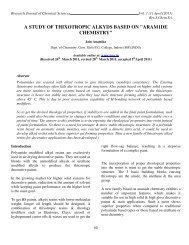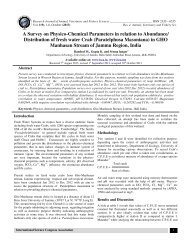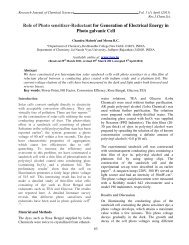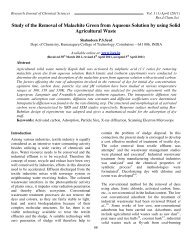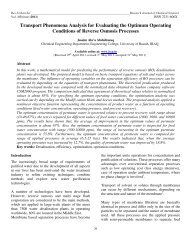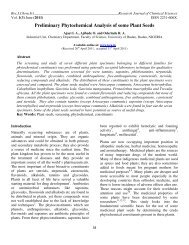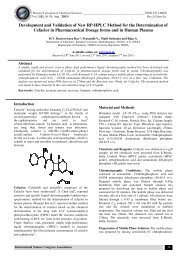Determination of Moisture Adsorption Isotherm of Shale from ...
Determination of Moisture Adsorption Isotherm of Shale from ...
Determination of Moisture Adsorption Isotherm of Shale from ...
You also want an ePaper? Increase the reach of your titles
YUMPU automatically turns print PDFs into web optimized ePapers that Google loves.
Abstract<br />
Research Journal <strong>of</strong> Engineering Sciences ___________________________________________ ISSN 2278 – 9472<br />
Vol. 1(4), 27-33, October (2012) Res. J. Engineering Sci.<br />
<strong>Determination</strong> <strong>of</strong> <strong>Moisture</strong> <strong>Adsorption</strong> <strong>Isotherm</strong> <strong>of</strong> <strong>Shale</strong> <strong>from</strong><br />
Agbada Formation Using GAB Model<br />
Dosunmu A. and Okoro E.E.<br />
Department <strong>of</strong> Petroleum and Gas Engineering, Faculty <strong>of</strong> Engineering, University <strong>of</strong> Port Harcourt, NIGERIA<br />
Available online at: www.isca.in<br />
Received 4 th October 2012, revised 16 th October 2012, accepted 20 th October 2012<br />
<strong>Shale</strong>s are susceptible <strong>of</strong> different phenomena, including swelling, shrinkage and hydration (shale instability); hence are<br />
impacted by moisture content. <strong>Moisture</strong> adsorption isotherms <strong>of</strong> shales <strong>from</strong> Agbada Formation were determined at 27 o C<br />
over a water activity (aw) range <strong>of</strong> 0.30 to 0.96 using a Static gravimetric technique. <strong>Moisture</strong> adsorption isotherms <strong>of</strong> these<br />
two shale samples <strong>from</strong> well A and well B exhibited the sigmoid type II and V shapes respectively. The Guggenhein,<br />
Anderson, de-Boer (GAB) model was applied to fit the experimental data satisfactorily. A non-linear regression analysis<br />
method was determined to evaluate the parameters <strong>of</strong> GAB sorption equations. The criteria used to evaluate the goodness <strong>of</strong><br />
fit to the model were Quadratic estimates, Central derivatives and Conjugate search <strong>of</strong> Micros<strong>of</strong>t Excel. The GAB model was<br />
used because it fit to the experimental adsorption data for a wide range <strong>of</strong> water activity (0.10 – 0.96) and the error square<br />
value calculated <strong>from</strong> Micros<strong>of</strong>t Excel was low. The estimated GAB parameters and constants were in good agreement with<br />
what the model dictates and with literature.<br />
Keywords: <strong>Shale</strong>, adsorption isotherm, GAB model, water activity, monolayer moisture content.<br />
Introduction<br />
<strong>Shale</strong>s are sedimentary rocks that have distinct laminated layers<br />
and moderate to high clay content. These distinct characteristics<br />
make them vulnerable to phenomena such as swelling,<br />
shrinking, hydration, strength reduction and ultimately failure 1 .<br />
Dzialowski mentions that over 90% <strong>of</strong> formations drilled<br />
worldwide are classified as shale formations. He further<br />
explains that about 75% <strong>of</strong> drilling operations’ problems are<br />
related to shales. Drilling problems have <strong>of</strong>ten been approached<br />
on a trial and error basis. Chenevert points out that one <strong>of</strong> the<br />
most important factors that lead to shale failure is that shales<br />
contain a significant amount <strong>of</strong> clay 1 . <strong>Shale</strong>s tend to hydrate<br />
when they come in contact with water. The transfer <strong>of</strong> water and<br />
ions <strong>from</strong> and to the shale alter the chemical and physical state<br />
<strong>of</strong> the shale 2 . Reactive clay minerals such as smectite have a<br />
higher number <strong>of</strong> active interlayers and increased isomorphic<br />
substitution than less reactive clays. <strong>Shale</strong>s with higher reactive<br />
clays will therefore have more area for monolayer coverage by<br />
water molecules before multiple layers begin to form. Chenevert<br />
studied the effects <strong>of</strong> water adsorption on shale samples. He<br />
found out that all the shale samples tested were altered as a<br />
result <strong>of</strong> water adsorption, especially Montmorillonitic shales 1 .<br />
<strong>Adsorption</strong> isotherms provide information on a material’s water<br />
content at certain equilibrium conditions. The behavior <strong>of</strong> a<br />
shale sample under these conditions can directly be related to its<br />
hydration and swelling potential. The isotherm can also give<br />
information on the expandable clay content <strong>of</strong> the shale.<br />
Chenevert studies shale preservation and testing techniques for<br />
borehole stability studies and found out that the controlled<br />
humidity desiccator technique, that is, the static gravimetric<br />
method, also known as the isopiestic method used to develop<br />
the shale adsorption isotherms is a convenient method for<br />
hydrating a sample without the risk <strong>of</strong> material loss; which is<br />
commonly associated with direct wetting in the presence <strong>of</strong><br />
water 2 . Chenevert presented a shale control technique using the<br />
concept <strong>of</strong> “Balanced water activity” in solving drilling<br />
problems associated with shales 3 . He stated that the main reason<br />
for shale instability during drilling with water-based fluids is<br />
water adsorption and subsequent swelling <strong>of</strong> the wellbore. In<br />
other words, water adsorption could be prevented if the water<br />
activity <strong>of</strong> the drilling fluid is the same as the water activity <strong>of</strong><br />
the shale pore fluid 4 . The moisture adsorption isotherm <strong>of</strong> this<br />
shale samples could be valuable information on solving the<br />
drilling problems encountered when tripping in or out <strong>of</strong> this<br />
shale formations since they give information about the<br />
humidity-water activity relation at a given temperature 5 . A<br />
number <strong>of</strong> models to describe moisture sorption isotherm have<br />
been proposed but the Guggenheim, Anderson and de Boer<br />
(GAB) model is considered to be the most versatile sorption<br />
model available in the literature 6 .<br />
The objectives <strong>of</strong> this study were, hence, to determine<br />
experimentally the equilibrium adsorption isotherm <strong>of</strong> this two<br />
Niger-Delta shale samples <strong>from</strong> Agbada formation and to model<br />
the adsorption characteristics using GAB equation.<br />
Material and Methods<br />
<strong>Shale</strong> samples <strong>from</strong> two wells in Agbada formation were used<br />
for this study. The first sample, Well A <strong>from</strong> Usan was cored at<br />
a depth <strong>of</strong> 2005 ft – 2006 ft. The second sample, Well B <strong>from</strong><br />
International Science Congress Association 27
Research Journal <strong>of</strong> Engineering Sciences________________________________________________________ ISSN 2278 – 9472<br />
Vol. 1(4), 27-33, October (2012) Res. J. Engineering Sci.<br />
Obagi was cored at a depth <strong>of</strong> 3462.91 ft – 3464 ft and<br />
preserved. The Static gravimetric method, also known as the<br />
isopiestic method was used to develop the shale adsorption<br />
isotherms. In this method, weight measurements were taken <strong>of</strong><br />
shale samples under varying relative humidity conditions at<br />
constant temperature and pressure. The relative humidity<br />
environments were created using saturated salt solutions in<br />
desiccators. The moisture adsorbed physically is the difference<br />
between the water content as expressed in initial weight and the<br />
water content at equilibrium known as the final weight <strong>of</strong> the<br />
sample. For this study, tests were carried out at ambient<br />
conditions. The adsorption isotherm curve is a plot <strong>of</strong> the<br />
amount <strong>of</strong> water adsorbed by the shale when placed in various<br />
desiccators versus the desiccator’s water activity. To prepare<br />
these desiccators, various kinds <strong>of</strong> saturated salt solutions were<br />
used to provide and maintain different relative humidity<br />
environments. Six saturated salt solutions [KCl, CaCl2, NaCl,<br />
K2SO4, KNO3 and Ca(NO3)2.4H2O] were used to provide<br />
constant water activity range <strong>from</strong> 0.3 to 0.96. These salt<br />
solutions were prepared with reagent grade salts and distilled<br />
water. The relative humidity data <strong>of</strong> the salt solutions were<br />
obtained <strong>from</strong> Greenspan. The shale samples were dried by<br />
placing them in an oven at 200 o F for 24 hours, and then the<br />
weight <strong>of</strong> each dry shale sample was measured. <strong>Shale</strong> samples<br />
are placed in several desiccators with different relative<br />
humidity. A vacuum is pulled on the desiccators in order to<br />
remove the air and accelerate the test towards equilibrium. As<br />
the shale adsorbs water, a weight gain is observed. Each shale<br />
sample is weighted daily until there is no further weight gain<br />
observed. The shale sample is in equilibrium with the<br />
atmosphere inside the desiccators when the shale sample weight<br />
becomes constant. The final weight <strong>of</strong> each sample is taken. The<br />
amount <strong>of</strong> water absorbed by the shale sample is calculated as<br />
the difference between the final weight and the dried weight.<br />
The shale water activity is determined by matching the native<br />
moisture content <strong>of</strong> the shale with its respective water activity<br />
value <strong>from</strong> the adsorption isotherm curve.<br />
Mineralogy: Mineralogy analysis indicates the relative<br />
quantities <strong>of</strong> compounds present in a rock. Clay and non-clay<br />
minerals are usually present in shales. The type <strong>of</strong> clay present<br />
is an indication <strong>of</strong> the degree <strong>of</strong> hydration experienced by the<br />
shale. It can be used to estimate the severity <strong>of</strong> wellbore<br />
instability issues that may arise. The mineralogy analysis for<br />
both Well A and Well B samples are presented in table-1. The<br />
Well A (Usan) cored at a depth <strong>of</strong> 2005 ft – 2006 ft, is made up<br />
<strong>of</strong> 20% quartz and 52% clay. It contains other non-clay minerals<br />
such as feldspar and carbonates in minimal amounts. The bulk<br />
<strong>of</strong> the clay content consists <strong>of</strong> illite and mixed clays with small<br />
amount <strong>of</strong> smectite. The existence <strong>of</strong> smectite indicates the<br />
probability <strong>of</strong> some swelling and dispersion in aqueous solution.<br />
Well B cored at a depth <strong>of</strong> 3462.91 ft – 3464 ft, is composed <strong>of</strong><br />
22% quartz and 51% clay. It also contains negligible amount<br />
non-clay minerals such as feldspar and carbonates. Zero<br />
smectite levels indicate low swelling tendencies.<br />
<strong>Adsorption</strong> <strong>Isotherm</strong> Model: The experimental data obtained<br />
corresponding to the water activity, aw and moisture content was<br />
adjusted to GAB (Anderson, 1946; de Boer, 1995; Guggenheim,<br />
1995) equations in order to determine the best fit.<br />
Data Requirements: At least 3 data points <strong>of</strong> a water activity, aw<br />
/ moisture measured at the same temperature, water activity, aw<br />
may be entered as a value or a salt, moisture may be entered as a<br />
value (dry or wet basis) or as a set <strong>of</strong> pan / sample weights.<br />
GAB Equation: This equation has a similar form <strong>of</strong> BET, but<br />
has an extra constant, K. BET is actually a special case <strong>of</strong> GAB,<br />
with K = 1. The GAB equation was used to model water<br />
adsorption <strong>of</strong> these shale samples as follows:<br />
International Science Congress Association 28<br />
m =<br />
������<br />
(1)<br />
������������������� Where m is the amount <strong>of</strong> sorbate adsorbed by 1g <strong>of</strong> sorbant at<br />
sorbate activity aw, Mo is the monolayer moisture content. C and<br />
K are GAB constants and are related to monolayer and<br />
multilayer properties 12 . The assumption <strong>of</strong> the GAB model over<br />
the BET (Brunauer, Emmett and Teller) 6 formulation stating<br />
that the sorption state <strong>of</strong> the sorbate molecules in the layers<br />
beyond the first is the same, but different to the pure liquid state,<br />
demands the introduction <strong>of</strong> the additional constant K 8 . C and K<br />
are related to the temperature effect being expressed by equation<br />
2 and 3:<br />
� = �� exp � ∆��<br />
�<br />
��<br />
(2)<br />
� = �� exp � ∆�� �<br />
��<br />
(3)<br />
Where ∆hc is the specific bonding enthalpy <strong>of</strong> water monolayer<br />
(J/kg), ∆hk is the mean specific bonding enthalpy <strong>of</strong> the water<br />
multilayer (J/kg), R is the universal gas constant (J/kg/K), T is<br />
the absolute temperature (K), ∆hs,mono is the specific sorption<br />
enthalpy <strong>of</strong> water monolayer (J/kg), ∆hvap is the specific<br />
vaporization enthalpy <strong>of</strong> water (J/kg), ∆hs,multi is the mean<br />
specific sorption enthalpy <strong>of</strong> the water multilayer (J/kg), Co and<br />
Ko are adjustable parameters accounting for temperature effect.<br />
∆ℎ � = ∆ℎ �,����� − ∆ℎ ���<br />
∆ℎ � = ∆ℎ �,���� − ∆ℎ ���<br />
The GAB equation can be rearranged to polynomial expression:<br />
��<br />
�<br />
�<br />
= �<br />
��<br />
�<br />
��� � �� � + � ���<br />
� �� +<br />
�∗��<br />
�<br />
�∗�∗��<br />
The modified GAB equation replaces C with C/T, where T is<br />
the temperature in o C. This enables isotherms to be estimated<br />
for any temperature, based on data measured at one temperature.<br />
However, the accuracy <strong>of</strong> this is approximate only, as it assumes<br />
all materials are affected by temperature identically.<br />
Model Validation: In this research, GAB equation was used to<br />
model the moisture adsorption isotherms for these shale<br />
samples. The experimental data were fitted to the model using a<br />
(4)
Research Journal <strong>of</strong> Engineering Sciences________________________________________________________ ISSN 2278 – 9472<br />
Vol. 1(4), 27-33, October (2012) Res. J. Engineering Sci.<br />
non-linear regression. All calculations were performed using<br />
Micros<strong>of</strong>t Office Excel 2007 solver and analysis toolpac. The<br />
coefficient <strong>of</strong> determination, R 2 , was calculated to give a<br />
measure <strong>of</strong> the proportion <strong>of</strong> variability attributed to the model.<br />
In addition to R 2 , the criteria used to evaluate the fit <strong>of</strong> GAB<br />
model were quadratic estimates, central derivative, conjugate<br />
search and error square (E 2 ) method <strong>of</strong> the solverpac. It is<br />
calculated as follow:<br />
�� = ∑ ����� − ����� �<br />
�<br />
��� (5)<br />
Where mexp is the experimental value, mpre is the predicted<br />
value, and N is the number <strong>of</strong> experimental data which is six<br />
(6). The lower the value <strong>of</strong> the error square, E 2 during the nonlinear<br />
regression; the better the GAB model curve fitting.<br />
Results and Discussion<br />
Experimental characteristic <strong>of</strong> moisture adsorption<br />
isotherm: The experimental moisture adsorption data obtained<br />
corresponding to the water activity values <strong>of</strong> the salt solutions<br />
which ranges <strong>from</strong> 0.30 to 0.96 are presented in figure 1 and 2.<br />
The adsorption isotherm for well A sample exhibited a shape<br />
similar to the sigmoid Type II as shown in figure 1. Type II<br />
sigmoid do not exhibit saturation limit. This type <strong>of</strong> isotherm<br />
indicates an indefinite multi-layer formation after completion <strong>of</strong><br />
the monolayer and is found in adsorbents with a wide<br />
distribution <strong>of</strong> pore size. The intermediate flat region in the<br />
isotherm corresponds to monolayer formation, following which<br />
adsorption occurs in successive layers. Several authors<br />
including Chenevert and Osisanya have reported isotherms with<br />
similar Type II shape 9,10 .<br />
The adsorption isotherm for Well B sample exhibited a shape<br />
similar to the sigmoid Type V as shown in figure 3. Type V<br />
adsorption isotherm shows phenomenon <strong>of</strong> capillary<br />
condensation <strong>of</strong> gas. The saturation level reaches at pressure<br />
below the saturation vapour pressure; this can be explained on<br />
the basis <strong>of</strong> possibility <strong>of</strong> gases getting condensed in the tiny<br />
capillary pores <strong>of</strong> adsorbent at pressure below the saturation<br />
pressure <strong>of</strong> the gas. It can be deduce <strong>from</strong> figure 2 and 3 that<br />
Well A has higher adsorptive potential than Well B and a<br />
conclusion that more adsorption took place in Well A than in<br />
Well B can be made; therefore more expandable clays are<br />
present.<br />
Modeling <strong>of</strong> <strong>Adsorption</strong> <strong>Isotherm</strong>: The Guggenheim,<br />
Anderson and DeBoer (GAB) model being the most commonly<br />
accepted model was used to fit the isotherms <strong>of</strong> <strong>Shale</strong> A and<br />
<strong>Shale</strong> B. The flexibility <strong>of</strong> the GAB isotherm has been attested<br />
through various literatures 4 . That is, it fits a wide variety <strong>of</strong><br />
materials. Other shale adsorption isotherms developed by<br />
Osisanya for Mancos, Wellington and Pierre shales were also<br />
fitted. This was done to investigate any possible trend with shale<br />
type and GAB model parameters. The most important parameter<br />
in the model is the monolayer moisture content Mo. Reactive<br />
clay minerals such as smectite have a higher number <strong>of</strong> active<br />
interlayers and increased isomorphic substitution than less<br />
reactive clays. <strong>Shale</strong>s with higher reactive clays will therefore<br />
have more area for monolayer coverage by water molecules<br />
before multiple layers begin to form.<br />
The experimental adsorption isotherm <strong>of</strong> Well A and Well B<br />
samples were fitted to the GAB model (equation 1). The most<br />
important parameter in the model is the monolayer moisture<br />
content Mo. Reactive clay minerals such as smectite have a<br />
higher number <strong>of</strong> active interlayers and increased isomorphic<br />
substitution than less reactive clays. <strong>Shale</strong>s with higher reactive<br />
clays will therefore have more area for monolayer coverage by<br />
water molecules before multiple layers begin to form. Thus, the<br />
Mo <strong>of</strong> reactive shale should be higher than that <strong>of</strong> less reactive<br />
shale. In our study, Well A and B have Mo values <strong>of</strong> 6.728 g/g<br />
(dry basis) and 2.999 g/g (dry basis). Thus, Well A is more<br />
reactive than Well B. Micros<strong>of</strong>t Office Excel solver was used to<br />
fit the curves to the model equation. It was programmed to uses<br />
a nonlinear regression-least squares method for curve fittings.<br />
The square <strong>of</strong> the correlation coefficient (R 2 ) for the fit should<br />
range between 0.9 and 1.00 to show a good fit for the model.<br />
The coefficients <strong>of</strong> determination (R 2 ) for fitting the GAB<br />
model was suitable and afforded the best fits to the experimental<br />
data because this model gave the best regression coefficient as<br />
shown in figure 3 and 4. Experimental data was inputted into the<br />
work sheet along with the model equation and the analysis <strong>of</strong><br />
the nonlinear regression-least squares method for curve fitting<br />
carried out (tables 2-5). The square <strong>of</strong> the correlation coefficient<br />
(R 2 ) for the fit ranged between 0.95 and 0.98 showing a good fit<br />
by the model. Well B fitted more GAB model than Well A shale<br />
sample. Another application <strong>of</strong> adsorption isotherm modeling is<br />
the determination <strong>of</strong> properties at temperatures other than the<br />
ambient. Most shale isotherms have been developed under<br />
ambient conditions. This is however not representative <strong>of</strong> in-situ<br />
conditions; generally, increased temperature will reduce<br />
adsorption to some degree 10 . These isotherms can be obtained<br />
by placing samples in a constant environment chamber at<br />
various temperatures and relative humidities. The temperature<br />
dependent parameters, C and K can be evaluated based on their<br />
variations with temperature. If a trend is established, predictions<br />
can be made for downhole temperatures or desired range <strong>of</strong><br />
temperatures. Table 2 estimated values <strong>of</strong> GAB model<br />
parameters and regression coefficient, R 2 . It has also been<br />
recognized that the fit become better as the determination<br />
coefficient approaches 1 and this is evident for the GAB model.<br />
Therefore, the GAB equation is optimal to fit the moisture<br />
adsorption isotherms <strong>of</strong> the shale samples. The parameter K is in<br />
keeping with sorption on multilayer above the first layer and the<br />
heat <strong>of</strong> vaporization <strong>of</strong> water. Thermodynamically, K’s needs to<br />
be smaller than 1.000. The value <strong>of</strong> K provides a measure <strong>of</strong> the<br />
interactions between the molecules in the multilayer with the<br />
adsorbent, and it tends to fall between the energy value <strong>of</strong> the<br />
molecules in the monolayer and that <strong>of</strong> liquid water. The fitting<br />
International Science Congress Association 29
Research Journal <strong>of</strong> Engineering Sciences________________________________________________________ ISSN 2278 – 9472<br />
Vol. 1(4), 27-33, October (2012) Res. J. Engineering Sci.<br />
<strong>of</strong> the isotherms with this model was high (R > 0.90) and in all<br />
cases the results obtained in the present work for the adjustment<br />
<strong>of</strong> GAB model to the different shale samples are in accordance<br />
with the limit values for constants C and K suggested by<br />
Lewicki, based on the mathematical analysis <strong>of</strong> the model (0.24<br />
< K
Research Journal <strong>of</strong> Engineering Sciences________________________________________________________ ISSN 2278 – 9472<br />
Vol. 1(4), 27-33, October (2012) Res. J. Engineering Sci.<br />
Table-2<br />
Coefficients for GAB <strong>Isotherm</strong>s for <strong>Shale</strong> A and <strong>Shale</strong> B<br />
Model Estimated Parameter Well A Well B<br />
GAB Mo 6.7284g/g (dry basis) 2.9987g/g (dry basis)<br />
K 0.7486 0.6410<br />
C 19.9324 18.7147<br />
R 2 0.95 0.98<br />
Standard Error 1.6890 0.3056<br />
Table-3<br />
<strong>Adsorption</strong> <strong>Isotherm</strong> Modeling for <strong>Shale</strong> A and <strong>Shale</strong> B<br />
Well A Well B<br />
mo = 6.7284 mo = 2.9987<br />
C = 19.9324 C = 18.7147<br />
K = 0.7486 K = 0.6410<br />
Aqueous Activity Experimental Data Model Data Aqueous Activity Experimental Data Model Data<br />
0.3 10.44 7.3962 0.3 2.55 3.0322<br />
0.51 11.23 10.0663 0.51 5.09 4.0136<br />
0.76 13.37 15.0383 0.76 5.17 5.5359<br />
0.86 16.36 18.3807 0.86 6.38 6.4040<br />
0.94 19.51 22.2396 0.94 6.93 7.2879<br />
0.96 27.26 23.4574 0.96 7.8 7.5443<br />
Table-4<br />
Well A Regression Statistics Summary Output<br />
Regression Statistics<br />
Multiple R 0.972494562<br />
R Square 0.945745674<br />
Adjusted R Square 0.932182092<br />
Standard Error 1.688980572<br />
Observations 6<br />
ANOVA<br />
df SS MS F Significance F<br />
Regression 1 198.9066425 198.9066425 69.72683923 0.001124419<br />
Residual 4 11.41062149 2.852655371<br />
Total 5 210.3172639<br />
Regression Statistics<br />
Multiple R 0.98853539<br />
R Square 0.97720222<br />
Adjusted R Square 0.97150277<br />
Standard Error 0.30556391<br />
Observations 6<br />
Table-5<br />
Well B Regression Statistics Summary Output<br />
ANOVA<br />
df SS MS F Significance F<br />
Regression 1 16.00869531 16.00869531 171.45566 0.000196402<br />
Residual 4 0.373477209 0.093369302<br />
Total 5 16.38217252<br />
International Science Congress Association 31
Research Journal <strong>of</strong> Engineering Sciences________________________________________________________ ISSN 2278 – 9472<br />
Vol. 1(4), 27-33, October (2012) Res. J. Engineering Sci.<br />
<strong>Moisture</strong> Content (Wt %)<br />
<strong>Moisture</strong> Content (Wt %)<br />
30<br />
20<br />
10<br />
8<br />
6<br />
4<br />
2<br />
0<br />
0<br />
0 0.2 0.4 0.6 0.8 1<br />
Aqueous Activity<br />
Figure-1<br />
<strong>Adsorption</strong> <strong>Isotherm</strong> for Well A<br />
0 0.2 0.4 0.6 0.8 1<br />
Exp<br />
30<br />
25<br />
20<br />
Mosture<br />
Content, wt(%)<br />
15<br />
10<br />
5<br />
0<br />
CaCl2<br />
Aqueous Activity<br />
Figure-2<br />
<strong>Adsorption</strong> <strong>Isotherm</strong> for Well B<br />
Ca(NO3)2.4H2O NaCl<br />
0 0.2 0.4 0.6 0.8 1 1.2<br />
Aqueous Activity, aw(%)<br />
Figure-3<br />
<strong>Adsorption</strong> <strong>Isotherm</strong> <strong>of</strong> Well A fitted to the GAB model<br />
International Science Congress Association 32<br />
KCl<br />
K2SO4<br />
KNO3
Research Journal <strong>of</strong> Engineering Sciences________________________________________________________ ISSN 2278 – 9472<br />
Vol. 1(4), 27-33, October (2012) Res. J. Engineering Sci.<br />
Conclusion<br />
The adsorption isotherms <strong>of</strong> Well A and Well B exhibit the<br />
sigmoid Type II and V behavior respectively, which is a<br />
characteristic <strong>of</strong> a multilayer. Generally, increased temperature<br />
will reduce adsorption to some degree. Most shale adsorption<br />
isotherms have been developed under ambient conditions;<br />
hence, activity values claimed to correctly balance the aqueous<br />
phase <strong>of</strong> the drilling fluid may in fact be incorrect. The<br />
experimental data was modeled using GAB equation and<br />
estimated parameters and the correlation coefficients (R 2 )<br />
indicate good accuracy with literature. Thus, it was<br />
demonstrated in this study that the GAB moisture adsorption<br />
isotherm model can be successfully applied to moisture<br />
adsorption by shale samples in the water activity, aw range<br />
between 0.30 and 0.96.<br />
Acknowledgements<br />
This work was supported by Pr<strong>of</strong>. Adewale Dosunmu, Mr &<br />
Mrs Okugo and Mrs Ethel Nmezi. Also the Department <strong>of</strong><br />
Petroleum Engineering and Plant Anatomy laboratories <strong>of</strong><br />
University <strong>of</strong> Port Harcourt, Rivers State, Nigeria.<br />
References<br />
1. Chenevert M.E., <strong>Shale</strong> Control ith Balanced Activity Oil<br />
Muds, JPT Trans AIME, 249, 1309-1316 (1970)<br />
2. Santos H.M.R., A New Conceptual Approach to <strong>Shale</strong><br />
Stability, Ph.D Dissertation, The University <strong>of</strong> Oklahoma,<br />
Norman, Oklahoma, 39 (1997)<br />
3. Chenevert M.E. and Pernot V., Control <strong>of</strong> <strong>Shale</strong> Swelling<br />
Pressures Using Inhibitive Water Based Muds, SPE 49263<br />
Figure-4<br />
<strong>Adsorption</strong> <strong>Isotherm</strong> <strong>of</strong> Well B fitted to the GAB model<br />
presented at the SPE Annual Technical Conference and<br />
Exhibition, New Orleans, September 27-30, (1998)<br />
4. Al-Awad N.J and Smart B.G.D., Characterization <strong>of</strong> <strong>Shale</strong>-<br />
Drilling Fluid Interaction Mechanisms Related to Wellbore<br />
Instability, J. King Saud Univ., 8(2), 187-215 (1996)<br />
5. Chenevert M.E. and Osisanya S.O., <strong>Shale</strong> Swelling at<br />
Elevated Temperature and Pressure, presented at the 33 rd<br />
Symposium in Rock Mechanics, Santa Fe, New Mexico,<br />
June 8-10, (1992)<br />
6. Anderson R., Modifications <strong>of</strong> the BET equation, Journal<br />
<strong>of</strong> the American Chemical Society, 68, 686–691 (1946)<br />
7. Anderson R., Modifications <strong>of</strong> the BET equation, Journal<br />
<strong>of</strong> the American Chemical Society, 68, 686–691 (1946)<br />
8. Brunauer S., Emett P. and Teller E., <strong>Adsorption</strong> <strong>of</strong> gases in<br />
multimolecular layers, J. American. Chem. Soc., 60, 309-<br />
319 (1938)<br />
9. Guizhong C., Chenevert M.E., Sharma M.M. and Yu M., A<br />
Study <strong>of</strong> Wellbore Stability in <strong>Shale</strong>s Including Poroelsatic,<br />
Chemical, and Thermal Effects, Journal <strong>of</strong> Petroleum<br />
Science and Engineering, 38, 167-176 (2003)<br />
10. Kahr G. and Madsen F.T., <strong>Determination</strong> <strong>of</strong> the Cation<br />
Exchange Capacity and the Surface Area <strong>of</strong> Bentonite, Illite<br />
and Kaolinite by Methylene Blue <strong>Adsorption</strong>, Applied Clay<br />
Science, 9, 327-336 (1995)<br />
11. Al-Muhtaseb A.H., McMinn W.A.M. and Magee T.R.A.,<br />
Water sorption isotherms <strong>of</strong> starch powders, Part 1:<br />
Mathematical description <strong>of</strong> experimental data, Journal <strong>of</strong><br />
Food Engineering, 61, 297–307 (2004)<br />
12. Adamson A.W., Physical Chemistry <strong>of</strong> Surface, 4 th Edition,<br />
John Wiley & Sons, 521-534 (1982)<br />
International Science Congress Association 33


